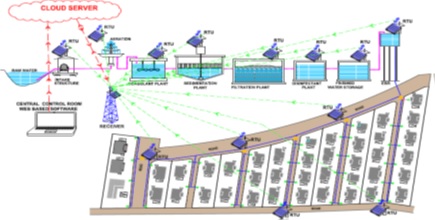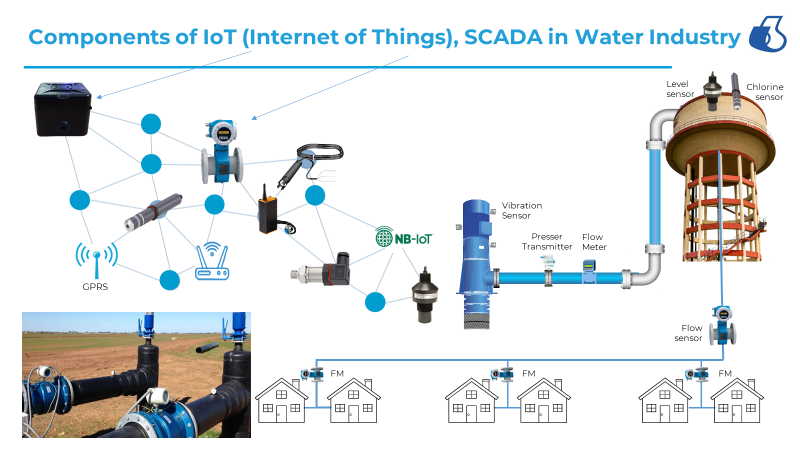By Dushyant Jindal, Co-Founder, Hitech Enviro Solutions
In the 21st century, clean water and environmentally friendly industrial processes are more critical than ever. According to the World Health Organization (WHO), contaminated drinking water causes 485,000 diarrheal deaths every year. Fortunately, proper treatment can help commercial and industrial facilities become more environmentally responsible and compliant in their wastewater disposal.
What Is Wastewater?
Wastewater is a complex matrix containing significant concentrations of solids (total solids 350–1200mg/l), dissolved and particulate matter (chemical oxygen demand 250–1000mg/l), microorganisms (up to 109 number/ml), nutrients, heavy metals, and micro-pollutants. Wastewater is any kind of used water affected by domestic, commercial, or industrial processes. The used water that flows out of a person’s house, a school or an office building is wastewater. So is the water produced during industrial operations like making paper or clothes or manufacturing chemical products. The composition of most wastewater is about 99.9% water by weight — the remaining 0.1% consists of contaminants like organic matter, inorganic matter and microorganisms that require removal.
Wastewater management system
Wastewater is any water that requires cleaning after it is used. This includes water that has been used for laundry, bathing, dishwashing, toilets, garbage disposals, and industrial purposes. Wastewater also includes rainwater that has accumulated pollutants as it runs into oceans, lakes, and rivers. Pollutants are unwanted chemicals or materials that contaminate air, soil, and water. The goal of wastewater management is to clean and protect water. This means that water must be clean enough so that it can be used by people for drinking and washing, and by industry for commercial purposes. It also must be clean enough to release into oceans, lakes, and rivers after it has been used. Wastewater is usually divided into two major groups: point source wastewater and non-point source wastewater. Point source wastewater includes wastewaters that enter natural waters (such as lakes, rivers, and oceans) from defined locations. The most common point sources are sanitary sewers and storm drains. Non-point source wastewater is wastewater that is not connected to a specific source. This includes runoff (water that drains away) from agriculture and urban (city) areas, and acidic waters from mines. In many ways, point source wastewater is much easier to manage because its source and the pollutants it contains are known. Non-point source wastewater, on the other hand, is both hard to identify and treat.
What Is Wastewater Treatment?
It used to be said that “the solution to pollution is dilution.” When small amounts of sewage are discharged into a flowing body of water, a natural process of stream self-purification occurs. Densely populated communities generate such large quantities of sewage, however, that dilution alone does not prevent pollution. This makes it necessary to treat or purify wastewater to some degree before disposal. Wastewater treatment applies special processes to wastewater to remove organic matter and other contaminants. Wastewater treatment programs aim to make the wastewater clean and safe enough to discharge back into the environment without harming nearby residents or the local ecosystem. Industrial wastewater usually contains a range of organic and inorganic matters in varying concentrations. Many materials are toxic, mutagenic, carcinogenic or almost nonbiodegradable. This contaminations and pollutants. Aerated activated sludge treatment has been known as one of the best solutions for secondary treatment. It is simple, cost-effective and high-performing. Combinations of anaerobic and aerobic treatment processes have been found to be efficient in the removal of many pollutants such as soluble biodegradable organic pollutants. The use of membrane-based technologies in industrial wastewater treatment is increasing. Chemical oxidation techniques to treat wastewater are also on the rise because of tighter treated wastewater limits. Both classical chemical treatment and advanced oxidation processes have been used in modern industrial wastewater units. Tertiary treatment usually includes final filter steps, polishing and finishing stages, e.g., widely used activated carbon filters. Eight Stages of the Wastewater Process
Stage One — Bar Screening Removal of large items from the influent to prevent damage to the facility’s pumps, valves and other equipment. The physical process of wastewater treatment begins with screening out large items that have found their way into the sewer system, and if not removed, can damage pumps and impede water flow. A bar screen is usually used to remove large items from the influent and ultimately taken to a landfill.
Stage Two — Grit Removal Removal of grit by flowing the influent over/ through a grit chamber. Fine grit that finds its way into the influent needs to be removed to prevent the damage of pumps and equipment downstream (or impact water flow). Too small to be screened out, this grit needs to be removed from the grit chamber. There are several types of grit chambers (horizontal, aerated or vortex) which control the flow of water, allowing the heavier grit to fall to the bottom of the chamber; the water and organic material continue to flow to the next stage in the process. The grit is physically removed from the bottom of the chamber and discarded.
Stage Three — Primary Clarifier Initial separation of solid organic matter from wastewater. After grit removal, the influent enters large primary clarifiers that separate out between 25% and 50% of the solids in the influent. These large clarifiers allow for the heavy solids to sink to the bottom and the cleaner influent to flow. The effectiveness of the primary clarification is a matter of appropriate water flow. If the water flow is too fast, the solids don’t have time to sink to the bottom resulting in negative impact on water quality downstream. If the water flow is too slow, it impacts the process up stream. The solids that fall to the bottom of the clarifier are known as sludge and pumped out regularly to ensure it doesn’t impact the process of separation. The sludge is then discarded after any water is removed and commonly used as fertilizer.
Stage Four — Aeration Air is pumped into the aeration tank/basin to encourage conversion of NH3 to NO3 and provide oxygen for bacteria to continue to propagate and grow. Once converted to NO3, the bacteria remove/strip oxygen molecules from the nitrate molecules and the nitrogen (N) is given off as N2 (nitrogen gas). At the heart of the wastewater treatment processmeans that the wastewater also contains a range of substances that cannot be easily degraded. Primary treatment involves the removal of solids, particles and oils in the industrial wastewater stream; therefore, primary treatment usually contains basic physical methods and solid/ oil separations such as primary clarifiers, oil separators and screens. Secondary treatment is usually the heart of the treatment unit where suspended and residual organics and compounds are broken down. Secondary treatment usually involves biological (bacterial) degradation of is the encouragement and acceleration of the natural process of bacteria, breaking down organic material. This begins in the aeration tank. The primary function of the aeration tank is to pump oxygen into the tank to encourage the breakdown of any organic material (and the growth of the bacteria), as well as ensure there is enough time for the organic material to be broken down. Aeration can be accomplished with pumping and defusing air into the tank or through aggressive agitation that adds air to the water. This process is managed to offer the best conditions for bacterial growth. Oxygen gas [O2] levels below 2 ppm will kill off the bacteria, reducing efficiency of the plant. Dissolved oxygen monitoring at this stage of the plant is critical. Ammonia and nitrate measurements are common to measure how efficient the bacteria are in converting NH3 to N2.
Stage Five — Secondary Clarifier Treated wastewater is pumped into a secondary clarifier to allow any remaining organic sediment to settle out of treated water flow. As the influent exits the aeration process, it flows into a secondary clarifier where, like the primary clarifier, any very small solids (or fines) sink to the bottom of the tank. These small solids are called activated sludge and consist mostly of active bacteria. Part of this activated sludge is returned to the aeration tank to increase the bacterial concentration, help in propagation, and accelerate the breakdown of organic material. The excess is discarded.
Stage Six — Chlorination (Disinfection) Chlorine is added to kill any remaining bacteria in the contact chamber. With the enhanced concentration of bacteria as part of the aeration stage, there is a need to test the outgoing effluent for bacteria presence or absence and to disinfect the water. This ensures that higher than specified concentrations of bacteria are not released into the environment. Chlorination is the most common and inexpensive type of disinfection but ozone and UV disinfection are also increasing in popularity. If chorine is used, it is important to test for free-chlorine levels to ensure they are acceptable levels before being released into the environment.
Stage Seven — Water Analysis & Testing Although testing is continuous throughout the wastewater treatment process to ensure optimal water flow, clarification and aeration, final testing is done to make sure the effluent leaving the plant meets permit specifications. Plants that don`t meet permit discharge levels are subject to fines and possible incarceration of the operator in charge.
Stage Eight — Effluent Disposal After meeting all permit specifications, clean water is reintroduced into the environment. There are additional industrial wastewater treatment technologies, including physicochemical, biological and advanced oxidation processes, used in processing industries. Oil removal Conventional approaches to treating oily wastewater have included gravity separation and skimming, dissolved air flotation (DAF), deemulsification, coagulation and flocculation. Gravity separation followed by skimming is effective in removing free oil from industrial wastewater. Oil-water separators such as the API separator and its variations have found widespread acceptance as an effective, low-cost primary treatment step. The API oil-water separator is designed to separate the oil and suspended solids from wastewater. An API separator or other basic oil-water separator, however, is not effective in removing smaller oil droplets and emulsions. Oil that adheres to the surface of solid particles can be effectively removed by sedimentation in a primary clarifier. DAF is one of the most effective methods to treat small oil droplets and emulsions. DAF uses air to increase the buoyancy of small oil droplets and enhance separation. Emulsified oil in DAF is removed by de-emulsification with chemicals, thermal energy or both. DAF units typically employ chemicals to promote coagulation and increase flock size to facilitate separation. Emulsified oil in industrial wastewater is usually chemically pretreated to destabilize the emulsion followed by gravity separation. The wastewater is often heated to reduce viscosity, accentuate density differences and weaken the interfacial films stabilizing the oil phase. This is followed by acidification and the addition of cationic polymer/alum to neutralize the negative charge on oil droplets, followed by raising the pH to the alkaline region to induce flock formation of the inorganic salt. The resulting flock with the adsorbed oil is then separated, followed by sludge thickening and sludge dewatering. Coagulation and flocculation Most industrial wastewater treatment units include sedimentation in their processes. Sedimentation, also called clarification, is a treatment process in which the velocity of the wastewater is lowered below the suspension velocity, and the suspended particles settle out of the wastewater due to gravity. Settled solids are removed as sludge, and floating solids are removed as scum. Industrial wastewater leaves the sedimentation tank over an effluent weir to the next step of treatment. The efficiency or performance of the process is controlled by retention time, temperature, tank details and other factors. However, without coagulation/flocculation, sedimentation can remove only coarse suspended matter that will settle rapidly out of the wastewater without the addition of chemicals. This type of sedimentation typically takes place in a reservoir, sedimentation or clarification tank at the beginning of the treatment process.
Coagulation/flocculation is based on the addition of chemical products that accelerate the sedimentation (coagulants) in the clarification tanks. The coagulants are inorganic or organic compounds such as aluminum sulphate, aluminum hydroxide chloride or high molecular weight cationic polymer. The purpose of adding coagulant is to remove almost 90 percent of the suspended solids from industrial wastewater at this stage in the treatment process.





